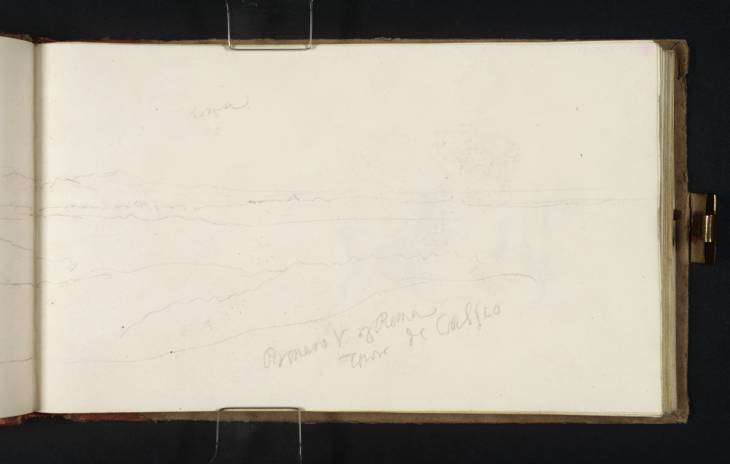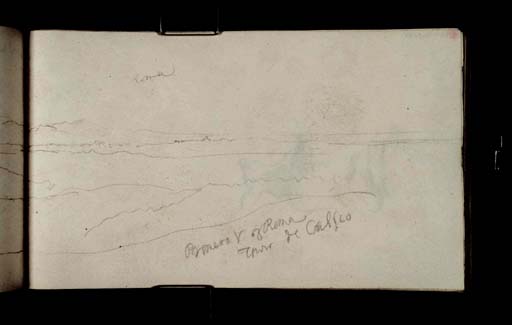Joseph Mallord William Turner Distant View of Rome, from the Road to the North 1819
Image 1 of 2
Joseph Mallord William Turner,
Distant View of Rome, from the Road to the North
1819
Joseph Mallord William Turner 1775–1851
Folio 85 Verso:
Distant View of Rome, from the Road to the North 1819
D14820
Turner Bequest CLXXVII 85 a
Turner Bequest CLXXVII 85 a
Pencil on white wove paper, 110 x 186 mm
Inscribed by the artist in pencil ‘Roma’ within sky, top left and ‘Primero V of Roma | Tower de Cassio’ bottom centre
Inscribed by the artist in pencil ‘Roma’ within sky, top left and ‘Primero V of Roma | Tower de Cassio’ bottom centre
Accepted by the nation as part of the Turner Bequest 1856
References
1909
A.J. Finberg, A Complete Inventory of the Drawings of the Turner Bequest, London 1909, vol.I, p.523, as ‘ “Primero V. of Roma. Tower de Cassio” ’.
1984
Cecilia Powell, ‘Turner on Classic Ground: His Visits to Central and Southern Italy and Related Paintings and Drawings’, unpublished Ph.D thesis, Courtauld Institute of Art, University of London 1984, pp.104, 470 note 158.
1987
Cecilia Powell, Turner in the South: Rome, Naples, Florence, New Haven and London 1987, p.35.
2008
Nicola Moorby, ‘Un tesoro italiano: i taccuini di Turner’, in James Hamilton, Nicola Moorby, Christopher Baker and others, Turner e l’Italia, exhibition catalogue, Palazzo dei Diamanti, Ferrara 2008, pp.101, 105 note 23.
2009
Nicola Moorby, ‘An Italian Treasury: Turner’s sketchbooks’, in James Hamilton, Nicola Moorby, Christopher Baker and others, Turner & Italy, exhibition catalogue, National Galleries of Scotland, Edinburgh 2009, pp.114, 155 note 24.
Although Turner’s travels through Italy had already taken him through much beautiful and interesting scenery in the northern lakes, Venice and Umbria, the principal objective of his tour was Rome and his anticipation must have been mounting on the final leg of his journey between Ancona and the Eternal City, the unrelenting stretch of road through the Campagna from Nepi. His excitement may be gauged by this sketch and its accompanying inscription recording his ‘Primero’ (first) view of Rome, a momentous moment for the forty-four-year-old artist. The drawing, which is inverted on the page, depicts the distant dome of St. Peter’s just visible on the horizon with the line of the Alban Hills beyond. Charlotte Anne Eaton, who published her reminiscences and letters from her travels in Rome in 1819, described her own first view of the city in Rome from the Nineteenth Century, published 1820:
Our longing eyes were intently fixed on the spot where we were told that it would first appear; when at length, the carriage having toiled up to the top of a long hill, the vetturino exclaimed, “Eccola!”. The dome of St. Peter’s appeared in view; and springing out of the carriage, and up a bank by the roadside, we beheld from its summit, Rome! It stood in the midst of the wide waste of the Campagna, whose brown landscape was glistening in the silvery dews of morning. In the hollow below us, a ruined Gothic tower, shaded by some straggling trees, formed a fine foreground to the view of the distant city. Its indistinct buildings formed a sort of long irregular line, in which the lofty dome of St. Peter’s, and the Castle of St. Angelo, once the proud Mausoleum of Hadrian, were alone prominent. Shall I venture to confess to you, that it was with eyes dimmed with tears that I gazed for the first time on Rome? I saw before me the great, the ancient, the eternal city.1
As recorded by Turner in his notes from John Chetwode Eustace’s A Classical Tour Through Italy (see Tate D13940; Turner Bequest CLXXII 5), a traveller’s first view of Rome was traditionally experienced on the heights above Baccano, approximately fifteen miles north of the city.2 However, the inscribed place name, ‘Tower de Cassio’, seems to indicate that Turner was somewhat further south, near the Torre del Cornacchie (Tower of Crows) or the Torre di Spizzichino, medieval towers on the Via Cassia, between La Storta and La Giustiniana. One of the towers is visible on the opposite sheet of the double-page spread, see folio 86 (D14821).
Nicola Moorby
November 2008
How to cite
Nicola Moorby, ‘Distant View of Rome, from the Road to the North 1819 by Joseph Mallord William Turner’, catalogue entry, November 2008, in David Blayney Brown (ed.), J.M.W. Turner: Sketchbooks, Drawings and Watercolours, Tate Research Publication, December 2012, https://www


